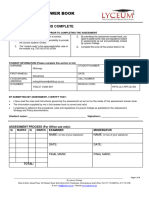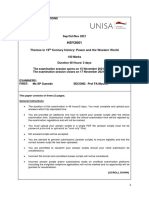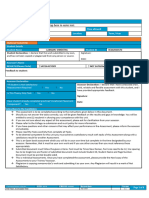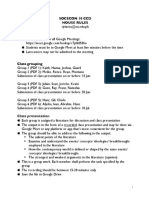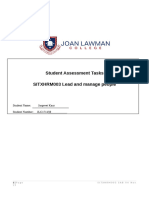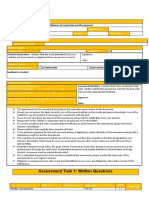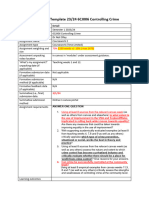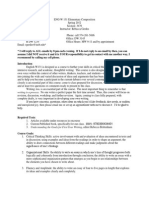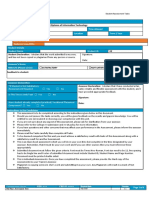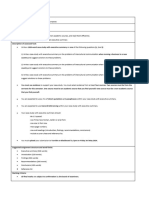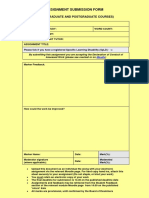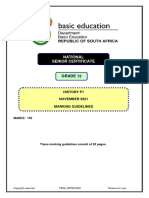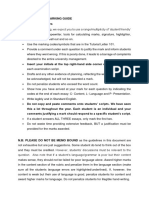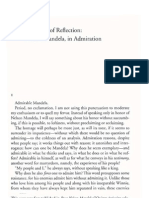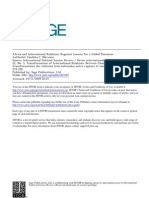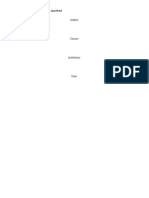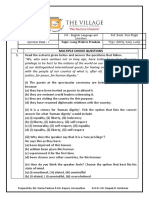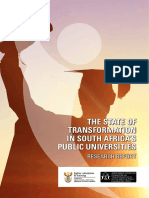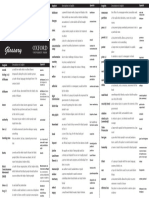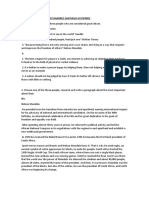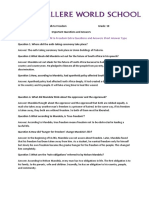ASSESSMENT ANSWER BOOK
STUDENTS TO READ AND COMPLETE
ALL INSTRUCTIONS MUST BE READ PRIOR TO COMPLETING THE ASSESSMENT
1. Ensure that your student number is correct. 5. By submitting this assessment answer book, you
agree to abide by the rules and regulations
2. Please note that it is your responsibility to provide related to assessments as set and periodically
the correct student number. revised by Lyceum College.
3. The "module code" is the seven/eight-letter code of 6. Complete the cover of this answer book in full.
the module, e.g. TSC1212/TSC1212N
STUDENT INFORMATION (Please complete this section in full)
SURNAME: Manduta STUDENT NUMBER: 170138
FIRST NAME(S): Wakisa Justene DATE: 20 July 2024
LYCEUM EMAIL 170138@lyceum.co.za CELL NUMBER: 066 153 3806
ADDRESS:
ID NUMBER: 0010200457082 MODULE CODE: DCL1437
BY SUBMITTING MY ASSESSMENT, I CERTIFY THAT:
· I have read the rules and instructions governing the assessment as set out on the inside of this assessment answer book.
· The information supplied by me in this answer book is correct and valid.
· I undertake to adhere to the procedures, rules and regulations of Lyceum College as published in the Assessment
Strategy and Policy documentation.
Student name: ____________________________________ Signature: _______________________
ASSESSMENT PROCESS (For Office use only):
Q MARKS Q MARKS EXAMINER MODERATOR
NAME: (in lieu of your signature) NAME: (in lieu of your signature)
DATE: DATE:
FINAL MARK: FINAL MARK:
TOTAL:
_______________________________________________________________________________ Page 1 of 13
© Lyceum College
Block A North, Adcorp Place, 102 Western Road, Gallo Manor Ext 6, Woodmead, Johannesburg, South Africa / Tel: 011 712 2000 Fax: 011 712 2156
E-mail: info@lyceum.co.za / Website:www.lyceum.co.za
� ASSESSMENT INSTRUCTIONS – READ AND FOLLOW METICULOUSLY
1. This Application-Based assessment is unsupervised. The College relies on the integrity and honesty
of students.
2. This Application-Based assessment is an open-book assessment. Nevertheless, your submission
must be entirely your own work.
3. Candidates must complete the assessment themselves and must sign the declaration form to
acknowledge the rules and instructions governing assessment on page 1 of this book.
4. Copying from a source, collusion with another student, or any other form of dishonesty found, will
lead to a mark of 3% for all involved, followed by disciplinary action
5. Should the College suspect that someone else has completed the assessment on a candidate’s
behalf, they will be subject to a disciplinary process and given a fail grade.
6. Candidates may not work in groups or consult others.
7. All quotations from paper or online sources must be properly identified and referenced in your work.
Lyceum uses the Harvard Referencing Style.
8. The College reserves the right to subject a candidate to an additional oral assessment should any
form of cheating be suspected.
9. Examinations (Summative assessments) will begin at the time and date specified on the latest
examination timetable.
10. Assignments (Formative assessments) will be due on the date specified in the Academic Calendar.
11. Application-based Assessments must be submitted within the specified time frames. No late
submissions will be accepted or marked. For assignments, late submissions will only be accepted
and marked if the student has been granted an extension from the College.
12. It is the responsibility of each candidate to ensure they have access to uninterrupted electricity and
internet for the duration of the assessment. The College will not be responsible for any power
failures during online assessments. Candidates are encouraged to make alternative arrangements
such as visiting an internet café or using a power bank if load shedding should occur in your area.
13. For summative assessments, candidates completing the Application-based Examination for
modules that are at NQF Level 6 have a maximum of 3 hours to complete the examination.
Candidates completing the Application-based Examination for modules that are at NQF Levels 7
and Level 8 have a maximum of 3.5 hours to complete the examination. An additional 1 hour is
provided to all students for downloading the examination paper, uploading the examination paper
and reading through the tasks.
_______________________________________________________________________________ Page 2 of 13
© Lyceum College
Block A North, Adcorp Place, 102 Western Road, Gallo Manor Ext 6, Woodmead, Johannesburg, South Africa / Tel: 011 712 2000 Fax: 011 712 2156
E-mail: info@lyceum.co.za / Website:www.lyceum.co.za
�14. For formative assessments, students have until 23:55 on the date of submission to upload their
assignment on the portal. Students are encouraged to submit assessments ahead of time to
prevent/address any problems with the uploading process.
15. No draft submissions will be graded.
16. Read the questions thoroughly.
17. Use the allocation of marks for each question as a guideline on how to structure your answer.
18. Candidates must answer all the questions.
19. Do not use WhatsApp language when answering questions. Such answers will not be marked.
20. Students who cannot type the assessment, may submit a handwritten assessment on the official
assessment answer book. The answer book needs to be scanned and uploaded via myClass as
shown in the video titled: “How to load assessments.”
21. Only PDF submissions will be accepted. Convert the assignment to PDF and upload it to myClass.
Any online PDF converter may be used. You may only upload one PDF document per submission.
22. Students are discouraged from choosing this option. Handwritten assessments will make the
marking process harder and slower and may prevent the College from giving timeous feedback.
23. Candidates who do not have access to myLyceum, must contact the College urgently.
24. Use one assessment answer book.
25. Complete the assessment cover sheet above and make sure that your institutional email address
and all other details are included. These pages must be included in your upload. Do not alter the
cover pages or format the document in any other way.
26. Clearly number your answers just as the questions are numbered in the question paper. Do
not change the numbering of the questions to the assessment.
27. Begin your first question at the top of the next page.
28. Do not use the right-hand margin. This is reserved for the marker.
29. Use 12-point size, Arial font and use 1,5 line spacing.
_______________________________________________________________________________ Page 3 of 13
© Lyceum College
Block A North, Adcorp Place, 102 Western Road, Gallo Manor Ext 6, Woodmead, Johannesburg, South Africa / Tel: 011 712 2000 Fax: 011 712 2156
E-mail: info@lyceum.co.za / Website:www.lyceum.co.za
� Leave Margin B
ANSWER ON THIS SIDE
Section A
Task 1:
1.1 In general redressing injustices of the past refers to the actions taken to address
and correct the historical wrongs and inequalities. In the context of apartheid, it means
correcting the injustices that was done under the apartheid regime.
Apartheid was based on Parliamentary sovereignty. During apartheid which was based
on racial segregation, policies and legislation was passed which excludes and denied
the basic rights of non-whites. Among other injustices, non-whites were not allowed to
vote or engage in politics and were reduced to labour for whites and were forced to live
in separate group areas. These injustices were justified by the government and treated
as a form of protection of white supremacy. Non-whites particularly black South Africans
were subject to a completely segregated education system in which many black schools
were in poor quality and under-resourced. When apartheid came to an end in 1994, the
new democratic government prioritized redress for the historically marginalized
populations. The adoption of the final Constitution in 1996 was a form of redress to
regulate the injustices done in the past and to afford everyone with equal rights,
protection and benefits of the law. In addition, education was also seen as a form of
redress, forming part of the South African Constitution in the Bill of Rights. A form of
redress was also the work of the Truth and Reconciliation Commission which was
formed to help deal with what happened under the apartheid laws. The purpose of the
Truth and Reconciliation Commission was to uncover truths about severe human rights
violations spanning from 1960 to 1994. Through over 2500 hearings, it allowed
individuals to seek amnesty and listened to around 21000 victims, with 2000 bravely
sharing their stories in public sessions.
1.3 According to Mignolo, the hidden agenda of modernity is coloniality. Modernity is a
difficult narrative and originated in Europe. Modernity is a self-serving narrative of
seamless progress resulting to more civilized and prosperous nations founded on global
principles and dual logic which separates object and subject, human and nature, reason
_____________________________________________________________________________
Use as many copies of this page as you need Page 4 of 13
© Lyceum College
102 Western Service Road, Gallo Manor Ext6, Woodmead, Johannesburg South Africa / Tel: 011 712 2000 Fax: 011 712 2156
E-mail: info@lyceum.co.za / Website: http: //www.lyceum.co.za
� Leave Margin B
and emotion. Coloniality can be seen as violent systems of oppression on which
modernity is based, such as colonialism, slavery and racism. Modernity is a narrative
that builds Western civilization by celebrating its achievements while concurrently hiding
in coloniality, which is its darker side or hidden agenda. Modernity cannot exist without
coloniality. As a result of Western modernity, coloniality took place. Crimes and violence
were justified in the name of Modernity. Coloniality is a tragic consequence of modernity
and has resulted in the global march toward decolonisation.
Task 2
2.1 In general terms, inequality is an unfair situation where some people have more
opportunities and benefits than others.
2.2 There are numerous factors contributing to the underperformance of South African
schools.
The educator’s lack of sufficient skills in adopting the curriculum to meet a variety
of learning demands. It appears that the training programmes for educators does
not sufficiently address this need, and as a result, stresses out teachers and
hinders the progress of learners with disabilities.
The deep-rooted socio-economic inequalities that persist in South Africa. A great
amount of learners from disadvantaged homes or backgrounds do not have
access to quality resources and infrastructure. Insufficient infrastructure
motivates these challenges which can result in sizable learning gaps across
various regions and communities. The quality of teaching, learning and
educational performance indicates generally poor learner performance.
Teacher shortages and quality. Motivated and qualified teachers in South Africa
are extremely scarce. The insufficient number of motivated and talented teachers
in South Africa intensifies the challenges faced by learners especially in rural
areas.
_____________________________________________________________________________
Use as many copies of this page as you need Page 5 of 13
© Lyceum College
102 Western Service Road, Gallo Manor Ext6, Woodmead, Johannesburg South Africa / Tel: 011 712 2000 Fax: 011 712 2156
E-mail: info@lyceum.co.za / Website: http: //www.lyceum.co.za
� Leave Margin B
The quality of education is reduced by the absence of continues professional
training and development for teachers which can lead to old and outdated
teaching methods and the inability to adjust to changing educational needs and
inclusive education.
Inadequate learning materials is also be a major problem in South Africa. These
includes the latest textbooks, funds to purchase exercise and workbooks and
core learning materials. Accessing some of these learning materials may involve
money, which many students may not have and with the absence of funding in
the
education system, learners cannot rely on the school to provide such essential
materials. This is a disadvantage and widens the gap between the rich and the
poor. The lack of sufficient resources has a a significant impact on the academic
performance of learners. This can result in declining enrolment and low academic
performance.
2.3 First-order changes are surface-level adjustments or updates to the existing system.
In the context of addressing inequalities in South African schools, first order changes
could include activities such as providing additional resources, instituting remedial
programmes or instituting temporary measures to address immediate inequalities.
These changes have a positive impact to a certain extent, as they do not address the
underlying causes of equality and may not result in long term changes.
On the other hand, second order change entails a more substantial and transformative
shift in the system. This is more than surface-level changes and seeks to reshape and
confront the root ideas, structures and practices which are the causes of the
continuation of equality. In the context of addressing inequalities in South African
schools, second-order changes may include activities such as, changing and amending
the curriculum, in order for it to be more inclusive culturally relevant, encouraging
_____________________________________________________________________________
Use as many copies of this page as you need Page 6 of 13
© Lyceum College
102 Western Service Road, Gallo Manor Ext6, Woodmead, Johannesburg South Africa / Tel: 011 712 2000 Fax: 011 712 2156
E-mail: info@lyceum.co.za / Website: http: //www.lyceum.co.za
� Leave Margin B
equitable access to education for every learner, addressing and discouraging
discrimination and empowering
disadvantaged communities. These changes aim to address to foundational causes of
inequalities and ensuring that everyone has equitable access to education.
_____________________________________________________________________________
Use as many copies of this page as you need Page 7 of 13
© Lyceum College
102 Western Service Road, Gallo Manor Ext6, Woodmead, Johannesburg South Africa / Tel: 011 712 2000 Fax: 011 712 2156
E-mail: info@lyceum.co.za / Website: http: //www.lyceum.co.za
� Leave Margin B
Section B: Medium Answer Questions
Task 3
3.1 In 1994, South Africa transitioned from the system of apartheid to one of majority
rule. In 1994, the first democratic election took place and the African National Congress
came into power.
The apartheid legal system was one of parliamentary sovereignty. The Parliament
which represented a small minority of South Africans founded on the interests of its
privileged white constituency, used its sovereignty to entrench the violation of human
rights. The apartheid system was based on racial segregation under the all-white South
African government. The apartheid government violated the rights of black people and
subjected them to socio-economic deprivation. Black South Africans were
disenfranchised, and many were removed from their property in a forceful manner and
also had their citizenship taken away. The all white government, forced non-white South
Africans to live in separate areas, use separate public facilities and prohibited contact
between the two groups. In addition, it became illegal for non-white South African
citizens to pursue interracial relations.
On May 1994, Nelson Mandela became the first black democratic president after
centuries of white rule. The fight to a democratic government was not only a matter of
race, but also of ideology. Democracy is an ideology. In other words, the fight for
freedom was not only a matter of color, but it also had ideological and economic
dimensions. The black majority now has more representation in government and access
to political decision-making. The power shit from apartheid to a democratic state did not
only involve the transfer of political power to the black majority, but also the
transformation of societal structures and the redistribution of economic resources. There
have also been efforts to address the injustices of the past and promote equality. In
_____________________________________________________________________________
Use as many copies of this page as you need Page 8 of 13
© Lyceum College
102 Western Service Road, Gallo Manor Ext6, Woodmead, Johannesburg South Africa / Tel: 011 712 2000 Fax: 011 712 2156
E-mail: info@lyceum.co.za / Website: http: //www.lyceum.co.za
� Leave Margin B
addition, initiatives were also implemented to empower marginalised communities and
address economic disparities.
3.2 The Bantu Education Act was promulgated in 1953. This Act was promulgated in the
interests of white supremacy. Racial segregation in education became mandatory under
this Act. Black people were denied access to the same education opportunities and
resources that white people enjoyed in South Africa. The Act was designed to control
the content of black education and to prevent black South African from receiving broad,
liberal education that would encourage and motivate anti-apartheid sentiments.
When the Act came into existence, financing for black schools were largely reduced,
resulting in inadequate infrastructure, overcrowding classrooms, undertrained teachers.
The curriculum for black schools were significantly altered. Subjects such as history,
mathematics, and science were abolished or taught in a manner that reinforced and
promotes the inferior status of black Africans. The Bantu Education curriculum was
created to teach and prepare black South African students for unskilled labour job
opportunities. They had subjects such as, Afrikaans, English, crafts, gardening and
sewing to be unskilled laborers such as gardeners and seamstresses. The government
used the education curriculum of black students to further racial segregation and to
brainwash black students into believing that they were not citizens of South Africa, their
own country. This was not only done to keep students in their own communities, but
also to meet the demand for unskilled and semi-skilled work in South Africa.
Black South African students under the Bantu Education Act, were denied access to
fundamental courses such as Science and Mathematics due to a lack of trained
educators. As a result, socio-economic opportunities of black South Africans were
negatively impacted, as subjects such as science and mathematics are valued in the
labour market. Black South Africans were limited to particular types of jobs after
completing their education as there were insufficient educated teachers to teach these
_____________________________________________________________________________
Use as many copies of this page as you need Page 9 of 13
© Lyceum College
102 Western Service Road, Gallo Manor Ext6, Woodmead, Johannesburg South Africa / Tel: 011 712 2000 Fax: 011 712 2156
E-mail: info@lyceum.co.za / Website: http: //www.lyceum.co.za
� Leave Margin B
subjects or skills. In addition, learners has to travel great distances to attend school.
There were also insufficient resources in schools, such as desks, tables and learning
material. Majority of the schools had to electricity, toilets, water and relied on feeding
schemes.
This deprived learners of acquiring important concepts and skills that would have
helped them in future career opportunities.
This Act negatively affected the quality of education for black learners. As a result, the
cycle of poverty and inequality continued for generations of Africans and they were ill-
equipped and unfit for anything beyond menial labor. Therefore, many South Africans
ended up illiterate. The Act also psychologically impacted black South African learners,
as its aim was to instill a sense of inferiority and subservience in black learners.
_____________________________________________________________________________
Use as many copies of this page as you need Page 10 of 13
© Lyceum College
102 Western Service Road, Gallo Manor Ext6, Woodmead, Johannesburg South Africa / Tel: 011 712 2000 Fax: 011 712 2156
E-mail: info@lyceum.co.za / Website: http: //www.lyceum.co.za
� Leave Margin B
Section C: Essay type questions/ Case studies
Task 5
5.1 The apartheid government intentionally segregated and underfunded black South
African schools and universities which led to significant educational inequalities. The
fees must fall movement was therefore considered as a continuation of the struggle to
access to education and inequality. The fees must fall movement had a great effect on
university fees and accessibility.
The fees must fall movement took place country wide and happened due to the
proposed increase in tuition fees for 2016. The fees must fall movement started
peacefully at numerous universities. The aim of the protest was to boycott the cost of
higher education as the majority of black South Africans could not afford those costs.
The protests within various universities were able to raise awareness about the lack of
funding for higher education. The student argued that they not only needed free
education, but free education which is decolonised. Students from different universities
interpreted decolonised education differently. For instance, University of Limpopo
students submitted that receiving education that is decolonised entails receiving
education of the same quality as students at historically white universities such as
University of Witwatersrand. Whereas other universities held that decolonised education
means that the curriculum must be changed to reflect African people’s lived
experiences. As a result of the various fees must fall protests, the state was under so
much pressure that Jacob Zuma, the president of South Africa, announced a 0% fee
increase for 2016. In addition, the government has also pledged to putting additional
funding into the National Student Financial Aid scheme (NSFAS) for the financial
_____________________________________________________________________________
Use as many copies of this page as you need Page 11 of 13
© Lyceum College
102 Western Service Road, Gallo Manor Ext6, Woodmead, Johannesburg South Africa / Tel: 011 712 2000 Fax: 011 712 2156
E-mail: info@lyceum.co.za / Website: http: //www.lyceum.co.za
� Leave Margin B
support of university students. It is clear that the protests were a successful means of
communication.
The fees must fall movement has had various positive impacts on university fees and
accessibility. First, the movement has made higher education more accessible to all
university students. Since the government introduced free higher education to students
with low household income, more students from marginalized communities have been
able to attend university and further their academic careers. Secondly, the protests have
also helped in the advancement of social justice by drawing attention to the inequalities
that existed in the education system. As a result, government officials have been
compelled to take reasonable measures to ensure that all students have equal access
to quality education. Thirdly, the protests have inspired universities to consider more
carefully on how to make education more inclusive and diverse. Therefore, numerous
institutions have added new courses and gave students a chance to interact with a
greater variety of viewpoints and ideas. This has benefitted students in a variety of fields
and disciplines by encouraging an environment of intellectual curiosity and innovation.
Finally, a more transparent and democratic form of governance within universities was
established as a result of the protests, giving students greater voice in decision making
processes. Ever since, choices on budgeting, fee structures and resource and facility
accessibility have involved students. As a result, institutions are now more accepting
and inclusive which has improved student’s mental and emotional well-being.
In short, the fees must fall movement was a great success. It also had a positive impact
on university fees and accessibility for all marginalised students who might not be able
to afford university fees.
_____________________________________________________________________________
Use as many copies of this page as you need Page 12 of 13
© Lyceum College
102 Western Service Road, Gallo Manor Ext6, Woodmead, Johannesburg South Africa / Tel: 011 712 2000 Fax: 011 712 2156
E-mail: info@lyceum.co.za / Website: http: //www.lyceum.co.za
� Leave Margin B
Bibliography
Mignolo WD
2011. THE DARKER SIDE OF WESTERN MODERNITY: Global Futures, Decolonial
Options. London: Duke University Press.
Seroto J, Davids MN, Wolhuter CC
2020. Decolonising Education in the Global South: Historical and comparative
international perspectives. Pearson: South Africa.
_____________________________________________________________________________
Use as many copies of this page as you need Page 13 of 13
© Lyceum College
102 Western Service Road, Gallo Manor Ext6, Woodmead, Johannesburg South Africa / Tel: 011 712 2000 Fax: 011 712 2156
E-mail: info@lyceum.co.za / Website: http: //www.lyceum.co.za

